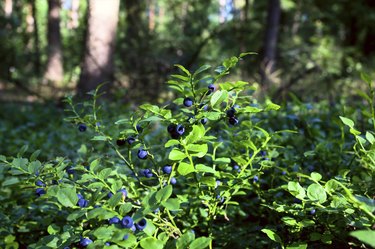
Blueberries are notoriously picky about the soil in which they grow, and they don't particularly like the kind of soil prevalent in most of Missouri. With some careful site selection and preparation, though, it's possible to successfully grow prolific blueberry bushes in the state.
Choosing Varieties
Video of the Day
Of the principal types of blueberry, northern highbush blueberries (Vaccinium corymbosum), most of which thrive in U.S. Department of Agriculture hardiness zones 3 to 8, fare the best in Missouri. Most of the state is too far north to successfully grow southern highbush or rabbiteye (Vaccinium ashei, hardy in USDA zones 7 through 9) blueberries and too far south for northern lowbush (Vaccinium angustifolium, hardy in USDA zones 2 through 8) varieties. Of the northern highbush cultivars, dozens will grow well in Missouri; choose a variety based on characteristics such as ripening time, berry size and per-bush yield.
Video of the Day
Choosing a Site and Planting
Blueberries like sites with full sun and well-drained soil that's rich in organic matter. Plant bushes in the late fall or early spring, spacing bushes 3 to 4 feet apart. Mix peat moss into the soil in the planting hole, and set the plants at the same depth at which they were growing at the nursery.
Soil Acidity
Blueberries are very particular about soil pH, and finding soil with the right level of acidity for optimum blueberry growth is difficult in Missouri. Blueberries need a soil pH level between 4.8 and 5.2, and most soils in Missouri are not that acidic. If your soil's pH is 6 or lower, you may be able to get it into the acceptable range by adding acidifying amendments such as powdered sulfur. The amount of sulfur you need to add will depend on your soil texture. Adding 1/2 to 3/4 pound of sulfur to 100 square feet of sandy soil will lower its pH by one point. Adding 1 to 1 1/2 pounds to medium-textured soil or 1 1/2 to 2 pounds to clay soil will do the same.
Fertilization and Watering
Blueberries need soil that is consistently moist but not saturated with water, as soggy soils may suffocate the plant's roots and kill the bush. In general, 2 inches of water a week should be enough. Blueberries prefer supplemental nitrogen in the form of ammonium sulfate rather than ammonium nitrate. Apply a 12-12-12 fertilizer at a rate of 1/10 pound per plant one month after planting, and then apply 2/10 pound in the second year when the plant begins to bloom. Apply 3/10 pound per plant at the beginning of the bloom period each year after that, following the initial application with two applications of 2/10 pound each at six-week intervals.
Pruning Bushes
Prune bushes using loppers or shears in late winter or early spring before the buds begin to swell, removing any weak or injured canes. Bushes produce berries on wood that is a year old, so leave enough new growth for good fruit production; you should, however, remove flower buds from bushes that are less than three years old to encourage healthy development of the plant. After the fourth year, remove about 20 percent of old canes with a long-term goal of making sure that all of the canes are always younger than six years old. To avoid spreading diseases, disinfect your pruning tools after each cut by dipping them in isopropyl alcohol or bleach.
Pests and Diseases
Blueberries are vulnerable to fungal diseases that can severely affect the health of the plant. The best way to control these diseases is to plant and prune the bushes so that there's good air circulation around their foliage. Promptly remove and destroy any infected stems or leaves, and don't allow dropped leaves or other debris to remain around the base of the plant.
- Missouri State University: Growing Blueberries in Missouri
- University of Missouri Extension: Fruit Production
- American Beauties Native Plants: Vaccinium Corymbosum "Northland"
- Blueberry Council of Missouri: Newsletter
- Berry Heaven USA: Rabbiteye Blueberry
- Fall Creek Farm & Nursery: Southern Highbush